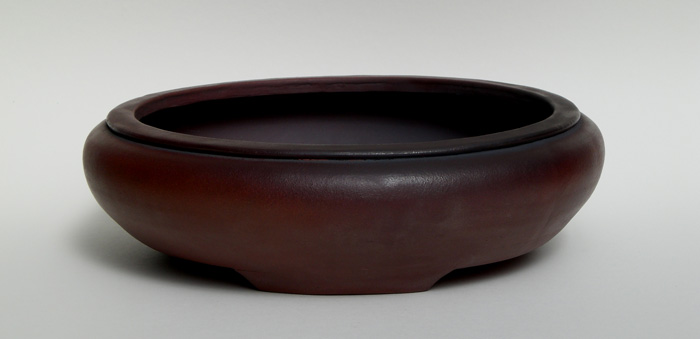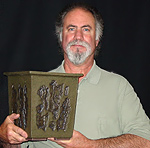Frost-resistant Pots ?
+3
prestontolbert
Will Heath
peter krebs
7 posters
Page 1 of 1
 Frost-resistant Pots ?
Frost-resistant Pots ?
Frost-resistant Pots?
Frost-resistance of a Pot
A bonsai pot is usually regarded as one unit, but glazed pots are composed of two different materials, which are the clay body of the pot and the glaze. The glaze, glossy or matt, ist the coating or the dress of a pot. Both the body and the glaze must match in their dilation characteristics, otherwise glaze fissures, glaze drips, blasted edges and similar glaze flaws can occur.
Let us regard the pot's body, the clay.
All sorts of clay are different because clay is a product of nature. You will hardly find two clay pits with the same clay quality. The potter must exactly determine which sort of clay he uses for his pots and at which temperatures he fires them to make them frost-resistant. The frost-resistance is calculated from the water absorptive capacity of the clay body.

Frost damage on a high quality Japanese pot.


Damage inside the pot.
The Test
Take a small clay slab and weigh it after high-firing or take a ready fired pot. Then cook it for about five minutes, so that small air-filled cavities can fill with water. Then weigh the slab or pot again. The weight may not increase more than 2% if the pot is to be frost-resistant. (By the way, a potter must guarantee this!)
The tight-firing temperature is that at which the clay gets a water absorptive capacity of less than 2%.

Firing Curve
The firing curve of a clay shows little contraction at the beginning (line 1). Approximately at 1000\u00b0C a contraction of the clay starts (line B1) up to a certain point at which the clay inflates and blisters for example (line C). From then on the clay melts together (line D).
The tight-firing curve lies before the bend of the curve (point A2). The bend marks the greatest contraction. The pyrometric cone equivalent (B2, for potters only) after the curve bend marks the greatest inflation.
Some clay almost tight-fires at 1200°C already but can endure a firing temperature up to 1700°C. It makes no sense however to fire bonsai pots this high just to reach a water absorptive capacity of 0.0% and it would be too risky too.
Up to 2% weight gain we speak of sintered ware, at 2 - 5% of semi-sintered (not frost-restistant), at more than 5% weight gain it is porose ware (absolutely not frost-resistant). So frost-resistance is linked with the porosity of a pot.
Porosity of a pot and the soil inside it
An important factor for the frost-resistance of a pot is also the soil. Normally the soil, especially Akadama-substrate, is porose enough to compensate the expansion of the ice inside the pot. A big drainage hole also helps to prevent the pot from filling up with water. There remain enough open pores in which the ice can expand without blasting the pot. (By the way, such damage must be covered by the owner of the pot).
The characteristics of the pot concerning frost (as described above) are connected to its porosity. The pot's body must not soak up water. By means of higher firing, the potter reduces the saturation ability. The pot must posess more closed and impermeable pores.
The pot's dress, the glaze
Porose fired pots must never be glazed because this would clog up the surface pores. Ice crystals then would be unable to emerge from the pores and would lift the glaze in chunks off the pot. A glaze alone does not make a pot frost-resistant. A tight-fired pot however does not soak up water, the ice can not endanger the pot so that it is frost-resistant. The pot and the glaze are a product of the fire. A bonsai potter must deal with the power of fire, because here most of the damages like firing fissures or glaze fissures occur. Glaze fissures, delicate to coarse ones, occur directly or some time after the firing process. These fissures are caused mainly by tensile stress of the glaze. Dilation differences between glaze and pot are responsible for this. This glaze flaw means a reduced frost-resistance!
Beware: Even craquelé glazes (in old China “cracked glaze”) are actually glaze flaws, only this flaw is produced intentionally. After high-firing delicate little tension fissures spread like cobwebs over the pot. Afterwards they are dyed dark to make them more visible. These pots also are not frost-resistant!
Two different firing processes, for example high-firing a pot, then applying a low-firing glaze and firing again, do not make a pot frost-resistant.
Another little frost-resistance test.
Hold the pot with thumb and forefinger (you can do this at your trader's or potter's place). The higher the sound when you strike the pot with the knuckles of the other hand, the more frost-resistant is the pot. The sound must be pure and long-lasting. If a pot is not frost-resistant, it has a dull sound and it does not last. Very experienced pot enthusiasts can even sense the frost-resistance of a pot with their tongue. Not frost-resistant pots feel as if you touched a blotting paper with the tongue. Frost-resistant pots feel like licking at a glass pane.
The “spittle test” works like this: put a small amount of spittle on your fingertip and then dampen the pot with it (on the inside of glazed pots). If the moisture is quickly absorbed, the pot is not frost-resistant; if the moisture stays long on the surface, it is frost-resistant.

The “Endurance Test”
Peter Krebs
All photographs and drawing by Peter Krebs
Translation: Heike van Gunst
Best regards
Peter
Frost-resistance of a Pot
A bonsai pot is usually regarded as one unit, but glazed pots are composed of two different materials, which are the clay body of the pot and the glaze. The glaze, glossy or matt, ist the coating or the dress of a pot. Both the body and the glaze must match in their dilation characteristics, otherwise glaze fissures, glaze drips, blasted edges and similar glaze flaws can occur.
Let us regard the pot's body, the clay.
All sorts of clay are different because clay is a product of nature. You will hardly find two clay pits with the same clay quality. The potter must exactly determine which sort of clay he uses for his pots and at which temperatures he fires them to make them frost-resistant. The frost-resistance is calculated from the water absorptive capacity of the clay body.

Frost damage on a high quality Japanese pot.


Damage inside the pot.
The Test
Take a small clay slab and weigh it after high-firing or take a ready fired pot. Then cook it for about five minutes, so that small air-filled cavities can fill with water. Then weigh the slab or pot again. The weight may not increase more than 2% if the pot is to be frost-resistant. (By the way, a potter must guarantee this!)
The tight-firing temperature is that at which the clay gets a water absorptive capacity of less than 2%.

Firing Curve
The firing curve of a clay shows little contraction at the beginning (line 1). Approximately at 1000\u00b0C a contraction of the clay starts (line B1) up to a certain point at which the clay inflates and blisters for example (line C). From then on the clay melts together (line D).
The tight-firing curve lies before the bend of the curve (point A2). The bend marks the greatest contraction. The pyrometric cone equivalent (B2, for potters only) after the curve bend marks the greatest inflation.
Some clay almost tight-fires at 1200°C already but can endure a firing temperature up to 1700°C. It makes no sense however to fire bonsai pots this high just to reach a water absorptive capacity of 0.0% and it would be too risky too.
Up to 2% weight gain we speak of sintered ware, at 2 - 5% of semi-sintered (not frost-restistant), at more than 5% weight gain it is porose ware (absolutely not frost-resistant). So frost-resistance is linked with the porosity of a pot.
Porosity of a pot and the soil inside it
An important factor for the frost-resistance of a pot is also the soil. Normally the soil, especially Akadama-substrate, is porose enough to compensate the expansion of the ice inside the pot. A big drainage hole also helps to prevent the pot from filling up with water. There remain enough open pores in which the ice can expand without blasting the pot. (By the way, such damage must be covered by the owner of the pot).
The characteristics of the pot concerning frost (as described above) are connected to its porosity. The pot's body must not soak up water. By means of higher firing, the potter reduces the saturation ability. The pot must posess more closed and impermeable pores.
The pot's dress, the glaze
Porose fired pots must never be glazed because this would clog up the surface pores. Ice crystals then would be unable to emerge from the pores and would lift the glaze in chunks off the pot. A glaze alone does not make a pot frost-resistant. A tight-fired pot however does not soak up water, the ice can not endanger the pot so that it is frost-resistant. The pot and the glaze are a product of the fire. A bonsai potter must deal with the power of fire, because here most of the damages like firing fissures or glaze fissures occur. Glaze fissures, delicate to coarse ones, occur directly or some time after the firing process. These fissures are caused mainly by tensile stress of the glaze. Dilation differences between glaze and pot are responsible for this. This glaze flaw means a reduced frost-resistance!
Beware: Even craquelé glazes (in old China “cracked glaze”) are actually glaze flaws, only this flaw is produced intentionally. After high-firing delicate little tension fissures spread like cobwebs over the pot. Afterwards they are dyed dark to make them more visible. These pots also are not frost-resistant!
Two different firing processes, for example high-firing a pot, then applying a low-firing glaze and firing again, do not make a pot frost-resistant.
Another little frost-resistance test.
Hold the pot with thumb and forefinger (you can do this at your trader's or potter's place). The higher the sound when you strike the pot with the knuckles of the other hand, the more frost-resistant is the pot. The sound must be pure and long-lasting. If a pot is not frost-resistant, it has a dull sound and it does not last. Very experienced pot enthusiasts can even sense the frost-resistance of a pot with their tongue. Not frost-resistant pots feel as if you touched a blotting paper with the tongue. Frost-resistant pots feel like licking at a glass pane.
The “spittle test” works like this: put a small amount of spittle on your fingertip and then dampen the pot with it (on the inside of glazed pots). If the moisture is quickly absorbed, the pot is not frost-resistant; if the moisture stays long on the surface, it is frost-resistant.

The “Endurance Test”
Peter Krebs
All photographs and drawing by Peter Krebs
Translation: Heike van Gunst
Best regards
Peter

peter krebs- Member
 Re: Frost-resistant Pots ?
Re: Frost-resistant Pots ?
Peter-
Val Cushing in New York, has a way to make mid fired sculpture frost proof. The technique involves making a granular low moisture mixture of 70% grog and 30% fireclay, and ram-packing it into a form. The result is sort of soft and crumbly till its fired. The fired result is very porous, yet vitrified. The porous nature allows ice to extrude from the surface. This might be applicable to slabs or carved pots. Also it has near zero% shrinkage.
Val Cushing in New York, has a way to make mid fired sculpture frost proof. The technique involves making a granular low moisture mixture of 70% grog and 30% fireclay, and ram-packing it into a form. The result is sort of soft and crumbly till its fired. The fired result is very porous, yet vitrified. The porous nature allows ice to extrude from the surface. This might be applicable to slabs or carved pots. Also it has near zero% shrinkage.

prestontolbert- Member
 Re: Frost-resistant Pots ?
Re: Frost-resistant Pots ?
Hi Will,
thank you for your interest in this article.
regards
Peter
thank you for your interest in this article.
regards
Peter

peter krebs- Member
 Re: Frost-resistant Pots ?
Re: Frost-resistant Pots ?
Hi Preston,
thank you for your participation.
Such a clay mix is also known in Europe. There are also some other compounds, for example, "Paperclay", not even the shrink.
Every potter should try it himself, I think the risk of frost is too large, in Germany there is in winter down to minus 25°C
For bonsai pots, it also depends on what surface you want.
I work with a clay that is very fat, 0.5cm grog and 25% share.

Diameter: 31 cm x 8,5 cm - hand made without mould, without potters wheel.
This clay is a diva, very moody, hypersensitive and very demanding.
With this clay you get a surface that is beautiful, these pots are eyecatching like a stone egg or beach pebble.
These surface are used for Juniperus chinensis, Pinus parviflora, azaleas, etc.
Rough or very rough surfaces are used for Pinus nigra, Pinus thunbergii Corticosa, Juniperus rigida, etc.
(sorry, translation is from Google)
regards
Peter
thank you for your participation.
Such a clay mix is also known in Europe. There are also some other compounds, for example, "Paperclay", not even the shrink.
Every potter should try it himself, I think the risk of frost is too large, in Germany there is in winter down to minus 25°C
For bonsai pots, it also depends on what surface you want.
I work with a clay that is very fat, 0.5cm grog and 25% share.

Diameter: 31 cm x 8,5 cm - hand made without mould, without potters wheel.
This clay is a diva, very moody, hypersensitive and very demanding.
With this clay you get a surface that is beautiful, these pots are eyecatching like a stone egg or beach pebble.
These surface are used for Juniperus chinensis, Pinus parviflora, azaleas, etc.
Rough or very rough surfaces are used for Pinus nigra, Pinus thunbergii Corticosa, Juniperus rigida, etc.
(sorry, translation is from Google)
regards
Peter

peter krebs- Member
 Re: Frost-resistant Pots ?
Re: Frost-resistant Pots ?
prestontolbert wrote:Peter-
Val Cushing in New York, has a way to make mid fired sculpture frost proof. The technique involves making a granular low moisture mixture of 70% grog and 30% fireclay, and ram-packing it into a form. The result is sort of soft and crumbly till its fired. The fired result is very porous, yet vitrified. The porous nature allows ice to extrude from the surface. This might be applicable to slabs or carved pots. Also it has near zero% shrinkage.
Very interesting Preson. I wonder how much flux content is in such a mixture. It doesn't sound like it would melt enough just by itself. Just curious, perhaps I could do some research.

Rob Addonizio- Member
 Re: Frost-resistant Pots ?
Re: Frost-resistant Pots ?
Interesting article peter, thanks.
Many of these comments/ideas have been bantered about throughout the internet and magazine articles for decades as I 'm sure you've seen. Especially concerning glazing inside or underneath pots. That one has sure received some ink over the years!
One thing I learned long ago as a bonsai person....If you live in an area that freezes in winter ( like I do) , and have chosen to do bonsai as a hobby ....you will have broken pots. Many folks are familiar with these effects especially with cheaper imported pots.
I almost always at shows have someone ask when looking at my pots " Will this pot break in winter?" and it usually turns into a longer answer than I'd like. I guess the best answer given for a high fired stoneware pot of good quality clay is..." It shouldn't, but it might".
Here are a couple shots of a fairly large and expensive Tokoname pot. I used to save lots of these pictures but now only have a few saved.
Dale



Many of these comments/ideas have been bantered about throughout the internet and magazine articles for decades as I 'm sure you've seen. Especially concerning glazing inside or underneath pots. That one has sure received some ink over the years!
One thing I learned long ago as a bonsai person....If you live in an area that freezes in winter ( like I do) , and have chosen to do bonsai as a hobby ....you will have broken pots. Many folks are familiar with these effects especially with cheaper imported pots.
I almost always at shows have someone ask when looking at my pots " Will this pot break in winter?" and it usually turns into a longer answer than I'd like. I guess the best answer given for a high fired stoneware pot of good quality clay is..." It shouldn't, but it might".
Here are a couple shots of a fairly large and expensive Tokoname pot. I used to save lots of these pictures but now only have a few saved.
Dale




Dale Cochoy- Member
 Re: Frost-resistant Pots ?
Re: Frost-resistant Pots ?
I guess another reason for living in Florida but still a good article - thanks Peter.

Rob Kempinski- Member
 Re: Frost-resistant Pots ?
Re: Frost-resistant Pots ?
Hi Dale,
thanks a lot for your photographs, this is a very good example.
On your pot both kinds of frost damage have occurred.
1) The chips that have come off were caused by water soaked into the clay body of the pot. Then frost has blasted the chips out.
2) The crack in the corner of the pot was caused by the pressure of frozen soil against the pot's walls.
All these mishaps don't occur if the pot is really frost-resistant.
regards
Peter
thanks a lot for your photographs, this is a very good example.
On your pot both kinds of frost damage have occurred.
1) The chips that have come off were caused by water soaked into the clay body of the pot. Then frost has blasted the chips out.
2) The crack in the corner of the pot was caused by the pressure of frozen soil against the pot's walls.
All these mishaps don't occur if the pot is really frost-resistant.
regards
Peter

peter krebs- Member
 Re: Frost-resistant Pots ?
Re: Frost-resistant Pots ?
Hello Rob,
it is unfair to tell me about Florida, I can only dream of going there.
In my region the weather gets colder now and it's raining, but its the perfect season for making pots.
In Florida, the Krebs would only laze around on the beach.
regards
Peter
it is unfair to tell me about Florida, I can only dream of going there.
In my region the weather gets colder now and it's raining, but its the perfect season for making pots.
In Florida, the Krebs would only laze around on the beach.
regards
Peter

peter krebs- Member
 Re: Frost-resistant Pots ?
Re: Frost-resistant Pots ?
peter krebs wrote:Hi Dale,
thanks a lot for your photographs, this is a very good example.
On your pot both kinds of frost damage have occurred.
1) The chips that have come off were caused by water soaked into the clay body of the pot. Then frost has blasted the chips out.
2) The crack in the corner of the pot was caused by the pressure of frozen soil against the pot's walls.
All these mishaps don't occur if the pot is really frost-resistant.
regards
Peter
Exactly Peter, although I have seen pots split down the sides with no other damage....from swelling. As I stated, this particular pot was NOT cheap and was a 'Tokoname' area kiln pot, soooo...Even they can break.
Even if they are "signed"
I have seen 20 degrees below zero F. here a few times in my life. I think most in freezing areas have seen the damage exactly as you show in your first photo. If you live in the north...you rarely save money with a $5-10 chinese pot.
D.

Dale Cochoy- Member
 Re: Frost-resistant Pots ?
Re: Frost-resistant Pots ?
Hello Dale,
unfortunately it is true that even very expensive and beautiful pots are not in all cases perfectly frost-resistant.
But even the best pots need some protective measures to survive very cold winters. If the soil is very dense, wet and thoroughly filled with roots the pot is in great danger of breaking. So I take care that my trees are repotted at least every two years (species with strong root growth each year) and I use soil that consists of coarse particles (a mixture of Akadama, pumice and a small percentage of high quality humus, plus, depending on the species, Kanuma or Kiryu). Between the particles there are sufficient air spaces which encourage healthy root growth and leave enough room for water expanding while freezing.
As we have a lot of rain and now and then some snow in winter (in Germany near Hamburg), I place the delicate trees in a greenhouse which is kept frost-free and all my hardy trees under the roof overhang of our house. This prevents the soil from getting too wet, which protects the trees (especially pine roots can die easily when they are kept wet constantly) and the pots.
Since I take these precautions (for several years now) no more pots have broken and I hardly lost any tree during winter.
Especially last winter the weather was very bad, it changed very often from mild and wet to very cold (down to -20°C) but nothing has happened to my bonsai pots.
Many greetings,
Heike

unfortunately it is true that even very expensive and beautiful pots are not in all cases perfectly frost-resistant.
But even the best pots need some protective measures to survive very cold winters. If the soil is very dense, wet and thoroughly filled with roots the pot is in great danger of breaking. So I take care that my trees are repotted at least every two years (species with strong root growth each year) and I use soil that consists of coarse particles (a mixture of Akadama, pumice and a small percentage of high quality humus, plus, depending on the species, Kanuma or Kiryu). Between the particles there are sufficient air spaces which encourage healthy root growth and leave enough room for water expanding while freezing.
As we have a lot of rain and now and then some snow in winter (in Germany near Hamburg), I place the delicate trees in a greenhouse which is kept frost-free and all my hardy trees under the roof overhang of our house. This prevents the soil from getting too wet, which protects the trees (especially pine roots can die easily when they are kept wet constantly) and the pots.
Since I take these precautions (for several years now) no more pots have broken and I hardly lost any tree during winter.
Especially last winter the weather was very bad, it changed very often from mild and wet to very cold (down to -20°C) but nothing has happened to my bonsai pots.
Many greetings,
Heike

Last edited by Heike_vG on Wed Sep 16, 2009 6:46 pm; edited 1 time in total

Heike_vG- Member
 Re: Frost-resistant Pots ?
Re: Frost-resistant Pots ?
Thank you Heike,
I rarely do have a pot break but in 32 years doing bonsai with as many as 425 trees in pots I've had a few!, especially with retail trees in 'less-expensive' pottery, but, once in a while something as shown. Yes, repotting often does help. I am now down to about 100, or a bit less, of personal trees in pots and the hardy ones are kept in my unheated greenhouse during the winter so they are pretty well protected but still freeze. The more 'touchy' hardy plants are placed into styrofoam boxes with holes in the bottom and then back-filled with mulch. i usually water 3-4 times during winter.
I still maintain.....If you are going to do bonsai....once in a while you are going to have a pot break
Dale
I rarely do have a pot break but in 32 years doing bonsai with as many as 425 trees in pots I've had a few!, especially with retail trees in 'less-expensive' pottery, but, once in a while something as shown. Yes, repotting often does help. I am now down to about 100, or a bit less, of personal trees in pots and the hardy ones are kept in my unheated greenhouse during the winter so they are pretty well protected but still freeze. The more 'touchy' hardy plants are placed into styrofoam boxes with holes in the bottom and then back-filled with mulch. i usually water 3-4 times during winter.
I still maintain.....If you are going to do bonsai....once in a while you are going to have a pot break
Dale

Dale Cochoy- Member
 Similar topics
Similar topics» First Pots
» Some of my new pots .
» Dan Bartons Kusamono Pots at Best of British
» Surprise from my kiln
» are modern pots going in the right direction? my thoughts and hopefully yours
» Some of my new pots .
» Dan Bartons Kusamono Pots at Best of British
» Surprise from my kiln
» are modern pots going in the right direction? my thoughts and hopefully yours
Page 1 of 1
Permissions in this forum:
You cannot reply to topics in this forum






